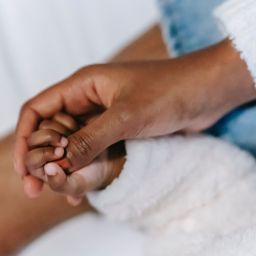
When I went into labor, I had one name in mind for my son: Caiden. Now, it’s worth mentioning that at the time, I was 17 years old, facing an unplanned pregnancy, and I went into labor at 25 weeks. Despite being 15 weeks premature, Caiden came out at a strong two pounds two ounces, and true to the meaning of his name, which is “fighter,” he’s been one ever since. Preemies often encounter a series of complications, and given how prematurely Caiden entered the world, there was a strong probability for a variety of complications. Fortunately, during a 91-day stay in the Neonatal Intensive Care Unit (NICU) and more immediate procedures than I could count, Caiden came home with only one lasting complication—retinopathy of prematurity.

According to the National Eye Institute, retinopathy of prematurity, or ROP, is a potentially blinding eye disorder that affects premature infants that are born before 31 weeks gestation. There are approximately 3.9 million infants born in the United States each year, and of those, it’s estimated that between 14,000 and 16,000 are affected by some degree of ROP. To put it into perspective, only about 400 to 600 infants born in the United States each year become legally blind from ROP. My Caiden is one of them.
When I heard the words legally blind, an immediate panic set in, leaving me wondering if my son would ever be able to see his fighting strength even if he couldn’t see the details of my face. However, what I’ve been most grateful to discover along our journey is that we were not alone. We were greeted with a wealth of resources and an entire community of accessibility and advocacy allies ready to help us along the way.
In our instance, Caiden can fully function in public school with services from his district’s low vision teacher. He can see 24-point font or larger, has had an iPad since he started school, and uses technology resources like preferential seating, an individualized education plan (IEP), Zoom text, and others, and building landmarking to successfully navigate his education in the classroom and while traveling throughout his building. Today, my legally blind sophomore is a Magna Cum Laude student. The only difference between him and other students is that he relies on tools to enlarge papers and reading materials so he can comfortably see them. But don’t get me wrong, I’ve had some major mom fails along this journey.
Take, for instance, when Caiden was eight, and he came downstairs with leftover toothpaste crusted around his mouth. I can’t remember if I was running late or just impatient in the moment, but Caiden stopped me in my tracks when he said, “Mom, I can’t see my face in the mirror.” But that wasn’t the only lesson I had to learn.
Teaching a young man to shave, safely cross the street, get off the bus and inside the house without an adult—all of these life lessons can cause nervousness for parents with children who have full accessibility. But for parents of children with disabilities, some of these lessons quickly become our greatest fears. Fortunately, Caiden and our village have shown me endless grace as I’ve learned to get comfortable growing through discomfort along our way.
But accessibility, and my awareness of the vast diversity in ability levels, have followed me into the office. As a marketer, communicator, and public relations practitioner, Caiden has tremendously impacted my ability to do my job well and in a way that makes a positive impact on those around me.
Watching my son navigate his disability is often on my mind as a reminder that effective campaigns should appeal to audiences of all ability levels. If you’re unsure where to take action, here are a few places to begin evaluating your inclusivity practices:
- Offering printed collateral in large print font.
- Ensuring that accurate Closed Captioning is included in all video content.
- Properly entering alternate text on the backend of a website.
- Offering close seating or individual copies of collateral for those who may not be able to see a presentation from a distance.
- Being mindful of color contrasting on presentations and websites that make it difficult for those impacted by low vision or color blindness.
- Ensuring interpreters are always visibly placed during presentations, and many more.
But set aside the ways I leaned into learning more about inclusive marketing practices, experiencing life with Caiden continues to help me refine the ways I show up as a human. Watching Caiden navigate his disability has greatly increased my patience, helped me communicate more clearly, and has reminded me that it’s important to try and see from a different perspective, even if the view is unclear. Ultimately, watching my son learn to navigate the world and overcome his limitations has reminded me that, with a little extra grace, we’re all capable of remarkable things.
As marketers, there are so many resources to help us be inclusive. This March, during Disability Awareness Month in Indiana, I both invite and challenge the Indy marketing community to embrace new audiences through inclusive efforts.
To learn more about Disability Awareness Month in Indiana, please visit the Governor’s Council for People with Disabilities’ website. Other resources on inclusivity include:
Casey Cawthon has been a lifelong Hoosier since she was two years old. Cawthon is a two-time graduate of IUPUI, most recently with her master’s in applied communication specializing in business media. Cawthon currently serves as the vice president of marketing and communications with the Indy Chamber and recently celebrated her tenth year as an associate faculty at IUPUI. Cawthon serves on the board of directors for the Indiana Fashion Foundation, is on the Rev 2022 engagement committee, is on the New Hope of Indiana marketing committee, and has served as a mentor through Pass the Torch for Women since 2019. When off the clock, Cawthon is often searching for the newest public art installation, traveling, or hanging out with her son, boyfriend, and rescue dog, Einstein.
All of our content—including this article—is completely free. However, we’d love if you would please consider supporting our journalism with an Indy Maven membership.






